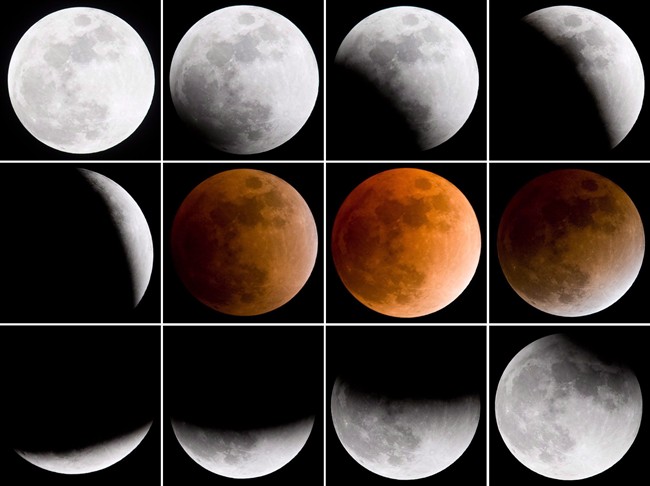TORONTO – This Wednesday, Canada will be treated to its second lunar eclipse of the year.

READ MORE: In Photos: Lunar eclipse produces ‘blood moon’ over Canada
The best place to be for this lunar eclipse is British Columbia and western Saskatchewan, where the whole eclipse can be viewed. For the rest of the country, the eclipse will end after moonset. And if you’re in eastern Canada, you’ll have to get up early: the total eclipse starts around 6:30 a.m. EDT.
The first stage of a lunar eclipse is the penumbral stage when the moon’s leading edge enters the outer fringe of Earth’s shadow, called the penumbra. It’s unlikely that you’ll notice anything until most of it has crossed into this region. Even then, you’ll only notice a slight darkening.
Total Lunar Eclipse of October 8, 2014 from Michael Zeiler on Vimeo.
Unlike solar eclipses, lunar eclipses are long events, spanning around three hours. So if you don’t want to get up too early, you can just get up for the totality, when the moon will be red.
READ MORE: April 15 starts off the year of eclipses
The partial eclipse starts when the leading edge of the moon enters the umbra, or Earth’s shadow. The rest of the moon will creep into the umbra. When all of it is in this shadow, we get the total eclipse.
Most of the time the moon isn’t blacked out, but turns a reddish or copper colour. This is because light from the sun — hidden behind Earth — refracts through Earth’s atmosphere. If an astronaut were on the moon, he or she would be able to see all the sunrises and sunsets occurring around the world at once.
READ MORE: Top 5 astronomical events you don’t want to miss
So, if you want to catch the lunar eclipse, you’ll need a clear sky and also the ability to either stay up late or wake up very early.
| City | Penumbral eclipse begins | Partial eclipse begins | Total eclipse begins | Total eclipse ends | Partial eclipse ends | Penumbral eclipse ends |
|---|---|---|---|---|---|---|
| Vancouver | 1:15 a.m. | 2:14 a.m. | 3:25 a.m. | 4:24 a.m. | 5:34 a.m. | 6:34 a.m. |
| Calgary, Edmonton, Regina, Saskatoon | 2:15 a.m. | 3:14 a.m. | 4:25 a.m. | 5:24 a.m. | 6:34 a.m. | 7:34 a.m. |
| Winnipeg | 3:15 a.m. | 4:14 a.m. | 5:25 a.m | 6:24 a.m. | 7:34 a.m. | 8:34 a.m. |
| Toronto, Montreal | 4:15 a.m. | 5:14 a.m. | 6:25 a.m. | 7:24 a.m. (moon will be just above horizon) | Not visible (moon has set) | Not visible (moon has set) |
| Halifax | 5:15 a.m. | 6:14 a.m. | 7:25 a.m. | 8:24 a.m. | Not visible (moon has set) | Not visible (moon has set) |
Unfortunately, the weather does not appear to be cooperating. Eastern Canada as well as parts of British Columbia are forecast to be covered in cloud. But of course, as we get closer to the day, the forecast may change.
As for the best way to catch the eclipse, all you have to do is look up. In eastern Canada, however, the moon will be setting, so try to get somewhere high and look to the west.
And we’re not done for eclipses this month: on Oct. 23, a partial solar eclipse will be visible across most of the country.
If you manage to snap a photo of the eclipse, please share it with us on Twitter @globalnews.
- Invasive strep: ‘Don’t wait’ to seek care, N.S. woman warns on long road to recovery
- Ontario First Nation declares state of emergency amid skyrocketing benzene levels
- T. Rex an intelligent tool-user and culture-builder? Not so fast, says new U of A research
- Nearly 200 fossil fuel, chemical lobbyists to join plastic treaty talks in Ottawa





Comments